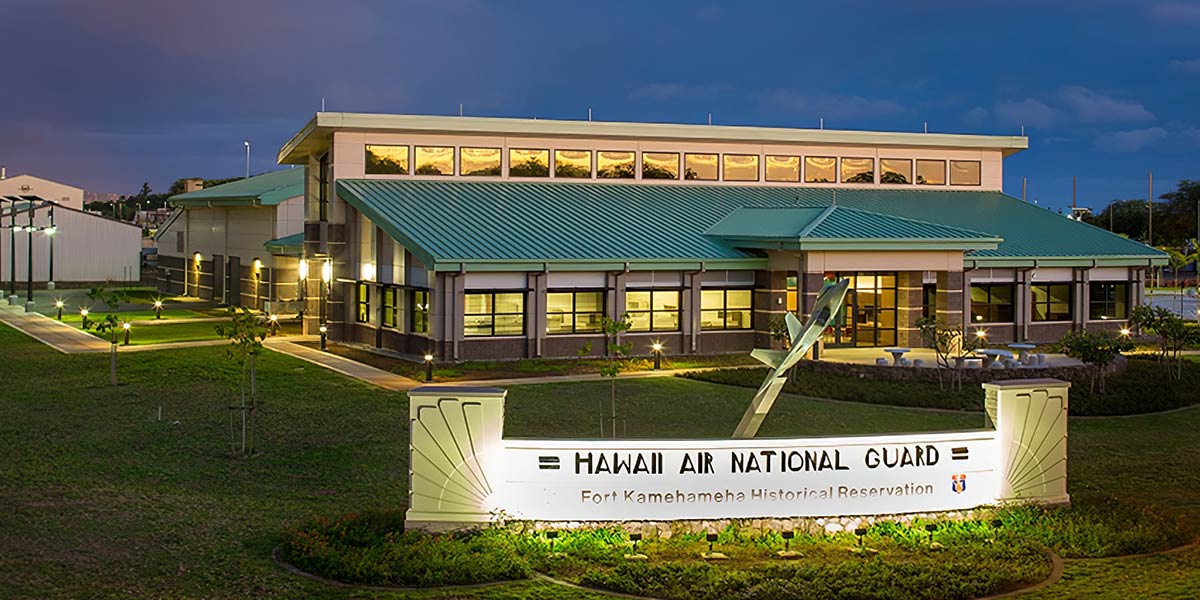Air Force Energy Supports Sustainable Microgrid Project - Energy Academic Group

F-22 Flight Simulator building at Joint Base Pearl Harbor Hickam, Hawaii, is part of the Pacific Energy Assurance and Renewables Laboratory, a renewable energy microgrid project demonstrating new ways for military facilities to address energy needs. Source: Burns & McDonnell
Air Force Energy Supports Sustainable Microgrid Project
By Corrie Poland, Air Force Operational Energy (SAF/IEN)
Article originally published January 22, 2020. Provided by the U.S. Air Force Air Combat Command and reprinted with permission.
The development of a sustainable microgrid power station is now underway for the Hawaii Air National Guard’s 154th Wing at Joint Base Pearl Harbor-Hickam (JBPH-H) after a traditional Hawaiian blessing ceremony kicked off the project on December 17, 2019.
The microgrid, which is being developed as part of the Pacific Energy Assurance Renewables Laboratory (PEARL), is designed to provide energy to the Wing through on-site energy sources, including fuel and solar power.
In contrast to centralized power grids that make up a majority of energy distribution systems, microgrids allow power to be stored and distributed directly to the end-user, instead of going through a large interconnected network of energy systems. In turn, microgrids offer a more resilient energy source, resistant to weather and external attacks, both physical and cyber-related.
As part of its goal to improve base resilience and provide energy assurance to the warfighter, Air Force Energy, leveraging congressional appropriations for ‘alternative energy’ research and development, allocated funding and provided support to PEARL from the outset of the project. Former Senator Daniel Inouye (D-HI), along with Senators Brian Schatz (D-HI) and Dick Durbin (D-IL), were critical champions for these alternative energy efforts.
“Establishing resilient energy sources at our bases is fundamental to Air Force mission success. PEARL is just one of the ways we are executing our energy strategy and ensuring installations have the robust and stable power they need,” said the Honorable John W. Henderson, Assistant Secretary of the Air Force for Energy, Installations, and the Environment.
The first phase of development, scheduled for completion later this year, will focus on constructing the microgrid system at JBPH-H by connecting the base’s existing solar array and a battery storage system to the local network. Phase two will incorporate solar to hydrogen for energy generation, storage, and utilization, and then culminate in the final phase of potentially powering the network with 100 percent on-site generated energy.
“Initiatives like PEARL help the Air Force improve mission resilience and provide secure, reliable power to our installations and critical facilities, and ultimately our Airmen,” said Mark Correll, Deputy Assistant Secretary of the Air Force for Environment, Safety, and Infrastructure.
The Office of the Assistant Secretary of the Air Force for Energy, Installations, and the Environment (SAF/IEN) enables Airmen to fly, fight, and win through ready installations, reliable environmental infrastructure, and resilient energy solutions.
LEARN MORE
For more information on energy optimization efforts in the Air Force, visit: safie.hq.af.mil/OpEnergy
Quarterly Newsletter
Surge is published quarterly by the Energy Academic Group and covers a divese range of energy-related topics. View archive

